Technique: South Balkan crumbly, brine-aged “white cheese”.
How a more salty feta-style can be made, based on my visit to Macedonia.
Crumbly White Cheese technique of the Mircheski Family.
See the video below for a demonstration of the make with commentary.
50 L goat milk is heated to 38c (100f). A lower temp is used when it is hotter outside. I believe this is mainly done because the uninsulated pot loses temp. You can use any temp that works, but set temp will effect coagulation in various ways.
Rennet is added, and the milk is left to set for 1 hour, until firm enough to cut.
A softer curd will potentially lead to a firmer cheese.
The curd is cut vertically in both directions, making a # pattern. This creates squarish pillars that are 5-8 centimeters (2-3 inches) wide.
After resting for 5 minutes - until clear whey has seeped out and the curd firms up a bit - a plastic scoop is used to remove the curd, placing it in a large rectangular draining form lined with very fine cheese cloth.
The whey drains slowly, so a knife is used to cut the curd further, and stir it, in the cloth. It is also scraped off the sides and turned. The cloth is pulled up on, and the curd rolled and pressed lightly.
As the whey drains off, more curd is added, over about 20 minutes.
Weight is applied and left to press for 1 hour. The compressed curd is then cut into blocks.
The blocks are hand salted, and left to absorb the salt, while moisture is pulled out, for about 30 minutes.
The blocks are packed tightly in a plastic bin or other vessel. Then the minimal amount of 20% brine (made from boiled water) is poured on to submerge the cheese. The mineral content of the salt will affect the ripening process, specifically whether it stays firm, or gets mushy. Aegean sea salt is what Daniel uses, it’s unclear to me how the mineral content of other sea salts compares.
A plastic sheet beneath a weight holds the cheese below the brine, as it ages for 1-6 months. This approach seems to lend itself to aging long term.
This follows my last post about the North Balkan soft white cheese that I saw and tasted in Bulgaria and Serbia. I think it is better to define it geographically, as an adaptation to the climate of the North Balkans, rather than as the possession of one country. I experienced a distinct variation of this feta-style in Macedonia, which is further to the south. It was firmer, and more salty. The maker, Daniel Mircheski, explained that once you get into the hotter Mediterranean zone, more salt is needed to preserve cheese. This higher salt level results in more moisture being pulled out of the cheese. The crumbly nature may have less to do with acidity than I had assumed.
I met Daniel at Slow Cheese in Bra, Italy this September. His cheese was part of a tasting I attended, and it impressed me with its unpretentious depth. I instantly perceived characteristics I associate with microbially rich milk, from animals enjoying a diverse diet. There was also a restraint and subtlety that I appreciate. Balance, with many voices harmonizing softly, no one dominating the choir with a loud, overbearing presence. Daniel only spoke for a few minutes, but I knew I wanted to meet him, to learn how this cheese is made. When I chatted with him, he immediately offered an invitation for me to come visit, promising he would show me everything. I could tell he was a solid dude; humble, and hospitable. His cheese spoke for itself. Daniel credits the goats and their milk for creating its delectable flavor.
This was the last leg of a trip with Marko Dordević , my friend I traveled with for 2 weeks in the Balkans. We arrived in Prilep and Daniel took us out for a local delicacy he knew I would enjoy: a sheep abomasum stuffed with the meat of other animals. The next day we visited an incredible Bazaar, full of vibrant produce, honey vendors, and a lovely cheese section. I saw no obvious tourists, and people were giving me looks that told me foreign visitors are uncommon here. I imagine that will change, and hope it does. The potential for food tourism here is vast, and any incentive that can be given to those upholding the region’s foodways should be kept on the table. Forward looking people like Daniel understand the value of what still exists here, and I encouraged him to consider offering a paid experience like the one he shared with me. Would you be interested in paying to see and partake in something like what is shown in the images in his post?
We went to the farm on the edge of town and met the herd of 35 Alpine goats. Daniel’s father Peter arrived, and took the gang out for their daily grazing circuit. They ran across fallow agricultural fields, to the locust trees growing in long margins between unfenced fields where alfalfa or vegetable crops had been harvested. Peter would shake the locust trees so the leaves showered down, the goats eagerly munching them up. This tree is valuable animal feed, and I see it growing all over the world in livestock-rich areas. The goats soon moved on to eat a leguminous plant growing semi-wild in the disturbed soils of the fields. Peter knew the local farmers, who were happy to have the goats come through, making water retaining divots with their hooves, depositing manure into the soil. As much as I like seeing grazing happening in remote mountains, it is more common globally for it to happen in crop - growing regions, as an intergral part of wider agricultural systems. People who raise crops often work with mobile pastoralists, to maintain fertility and clean up post harvest, while livestock get fed. It can, and in many places still does, all go together. When people argue we should just grow and eat plants, and not keep domestic livestock, they are ignoring a crucial component of how plant foods have been grown and soil fertility maintained successfully for millennia.
Peter wasn’t really herding the goats he explained, he was following them and encouraging them to move on before they overate any protein rich plants, or got into a place they shouldn’t be. Which is a very goat thing to do. Show me a wall, and I’ll show you how high I can climb. Goats eat a huge range of foods, but are highly selective. They often prefer the woody plants that other livestock won’t eat due to bitterness and medicinal/toxic compounds. The flavor compounds of these plants (and I believe healing powers) can concentrate and pass into milk.
This is one reason goat milk is considered medicinal by so many cultures. Because it is, if we let the goat be goats, the way Peter does.
After few minutes of following along as the goats ran ahead of us, I could see that Peter was actually one of them. He spoke to them in a conversational way, like a father to his children. Lovingly, but also with an air of playful discipline. Calling them by name. “Come on Bambi, hurry up!! She’s always last” he remarked with a warm grin. They responded with bleats and easy to interpret body language. Marko translated the things Peter said, as he waxed poetically about his love for his goats. “When they are eating, I gain nourishment as well. I feel calm, yet energized once they lay down to digest their meal”. He is a firm believer in the health boosting power of goat milk. He told a story of a friend of his who did not visit a doctor until he entered the military in his 20s. Born at home, he was given goat colostrum as an infant, in addition to that from his mother. As a child he drank goat milk daily. The ultimate, probiotic, immune system building diet. Milk represents life. There are 2 approaches towards milk, and life: probiotic and antibiotic. You are either working with life or against it.
I had an unforgettable flavor immersion that night. Daniel cut a slab of cheese that was at least 500 grams. I sat watching it as the other food was put on the table. I was hoping it would be as good as I remembered. The first juicy bite crumbled in my mouth. It had the same taste that had impressed me back in Italy. I also had the late lactation milk fresh from the goats in a glass. It had the same profile: goats, grass, extra cream, herbs, and a vague background richness and mineral/eggy character I have only seen in the milk of cows before, that were heritage breeds feeding on diverse open rangeland. I would take a bite of the salty cheese, then wash it down with the warm milk, creating a perfect balance and state of bliss. Why don’t more people pair their cheese with a glass of the raw milk from which the cheese was made? These things are served not as pairings, but as a matter of course, by hospitable families engaged in dairying around the world.
I will now explain the method Daniel demonstrated, and contrast it with the soft white cheese I observed in Serbia. I will refer to that cheese, which I posted about here, as the “Serbian make”.
We poured 50 liters of milk into a large pot, in a garage at Daniel’s home. He ages the cheese in a basement bathroom, as it is the coolest room in the house. This is a truly homemade food, but on a slightly larger scale than what the term generally refers to. The milk was heated, then rennet added when the temperature reached 38c. (100F). He uses a product found in Turkey and the Balkans, often labeled as Super Maya. It is microbial rennet from what I can gather, with the name Mucor miemei seen on the bottle. Like many places I visit, I was told people formerly made rennet from their herds, but the practice has been abandoned. Suckling lamb and goat kid are both local delicacies here, for me indicating a possible historical tie with dairying and rennet making. Like the Serbian make, we waited an hour, then saw that it wasn’t firm enough, so waited another 10 minutes. It was very casual, with none of the fussiness that I and other makers in less civilized countries tend to exhibit. Chuck the rennet into still milk, stir it a bit, and let it sit until its ready.
No starter culture was added, and I have been surprised to see this in a number of the places I have visited in the Balkans and Caucasus. Surprised because the tentacles of Danisco/CHR Hansen are reaching most of the planet, with their packaged starters and coagulants. The curd was cut vertically, into much wider pillars than the Serbian make. This was allowed to rest until a thin layer of whey had seeped out, about 6 minutes. Then it was ladled out, into a rectangular plastic box that formerly housed bullets. It was lined with a cloth baby diaper (never used for that use!) repurposed as a cheese cloth. I love these little details. Bullets, diapers, a garage. No wonder it’s such a good cheese.
I was confused, this process was so close to the much softer Serbian make. As the curd slowly drained in the cloth, inside the plastic box, it was stirred with a knife, cutting the curd smaller. This step changes everything, releasing whey that would otherwise be kept inside. The cloth was pulled up on much more aggressively, rolled, and pressed by hand. The process took longer, as Daniel allowed the curd to drain, then stirred and added more. The other factor is the much stronger brine, pulling more moisture out of the cheese. The curd was pressed with a significant amount of weight, in the form of granite blocks that fit perfectly in the form. He estimates this is about the same weight as the cheese curd at this stage. It was actually a lot less weight than the Serbian make.
After pressing for an hour in the plastic bin, the curd has a texture similar to firm tofu, and is cut into blocks. These were hand salted. This surprised me, as the fermentation would now be slowed. This is a technique I have seen in other hot climates, were milk ferments rapidly. It’s often more about slowing this process down, putting the brakes on, and getting the savory Savior that is salt in there ASAP. It is a big deviation from the Serbian make - and most cheeses - where fermentation proceeds overnight before salt is applied. The coarse salt absorbs for 30 minutes, with moisture pooling up on a plastic tray. The blocks are cut to fit tight in plastic buckets, brine poured in, a plastic disk put on top, and a weight of white marble applied.
The material of the weight used to hold brine aged cheese down is a detail I hadn’t considered. I asked what this white stone block was, and was told it is called Belutrak, a white marble, that is used with many ferments. They showed me their kraut, which had the same white block on top of woven grapevine mats, holding the cabbage heads under their salty sea. Daniel told me the stone absorbs water. Or the microbial soup that is cheese brine or kraut juice. The same stones are used for years. It is possible they are serving as reservoirs for beneficial microbes, carrying the terroir of a home, of the milk fermentation practices of a family, from one batch of brine to the next. This could likely be mimicked by adding a small dose of old brine to the new. But this use of porous materials impressed me. There is always a new element to the puzzle that is cheese that I hadn’t considered. Each step has so many variations and alternative approaches. I am reminded again, materials matter. The brine is deep, mysterious, and inhabited by miniature but mighty deities.
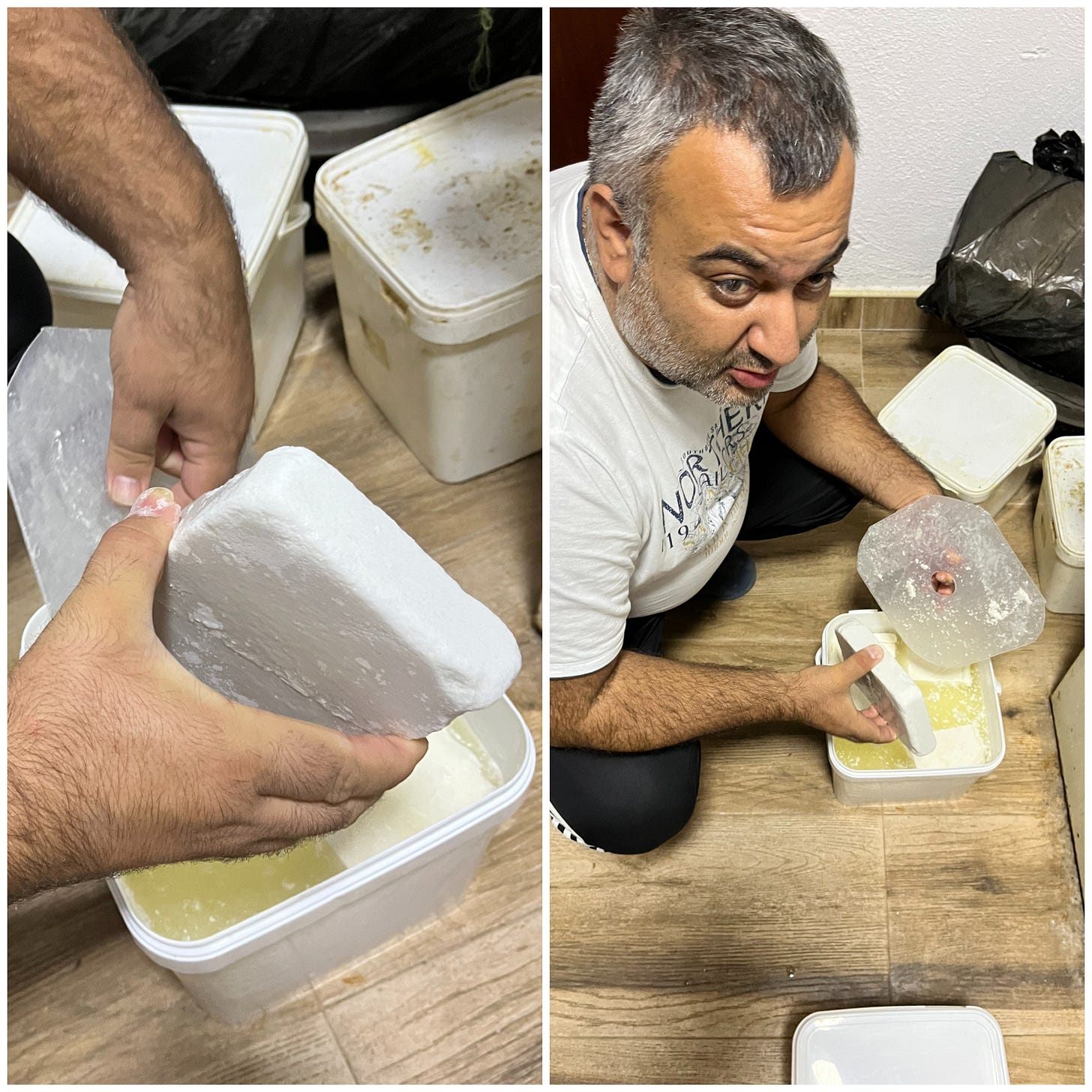
Brine is the defining component of this style. Of course how it is made (what salt and liquids are used) is crucial. Before starting the cheese, we prepared the brine, by adding salt at a rate of 20% to boiling tap water. It was Aegean sea salt, and Daniel says using this prevents the cheese from getting slimy. This tells me it has an adequate mineral content - mainly calcium - to maintain the firmness of the cheese. It’s the strongest storage brine I’ve ever seen used, and the fact that it was water rather than whey broke with the approach I generally advocate. I asked about this, and Daniel said using straight whey would change the fermentation. He explained that the salt would pull whey out of the cheese, making the brine flavorful and diluting it. He estimated that at the end of aging (2-6 months) the brine would only be 10% salt, half of its starting concentration. He says the cheese loses 15 - 20% of its weight. That’s a lot of whey, and another method of going about constructing a brine is this whey/water combo. Another factor: the cheese blocks fit snuggly in the containers, so there was not much brine in each one. This allows the proper dilution to take place. The ratio of cheese to brine is something to consider, and a reason why a 20% brine can be used.
The final cheese was overly salty for me, but this is true to the local style. I imagine it was in the 3 - 4% range. It seems that a cheese wont actually become as salty as the storage brine, which is why many people use an 8-10% solution. The local legend is that people would salt the cheese hard so it would last longer, you can only eat so much in one sitting. Daniel’s white cheese is among the top three I’ve tasted, and I look forward to experimenting further with these two methods of making soft and firm fetas in upcoming Sour Milk School events. Like the next one happening in January in Rajasthan, India, with a project called Camel Charisma. We will make a buffalo feta, and maybe, just for fun, a Camel milk one.
Where have you experienced either firm or soft brine aged cheese?
How do you feel about the use of cow, goat, sheep, or a blend of milks for making this style?
What has your experience been with using water, whey, or other liquids in brined cheeses?




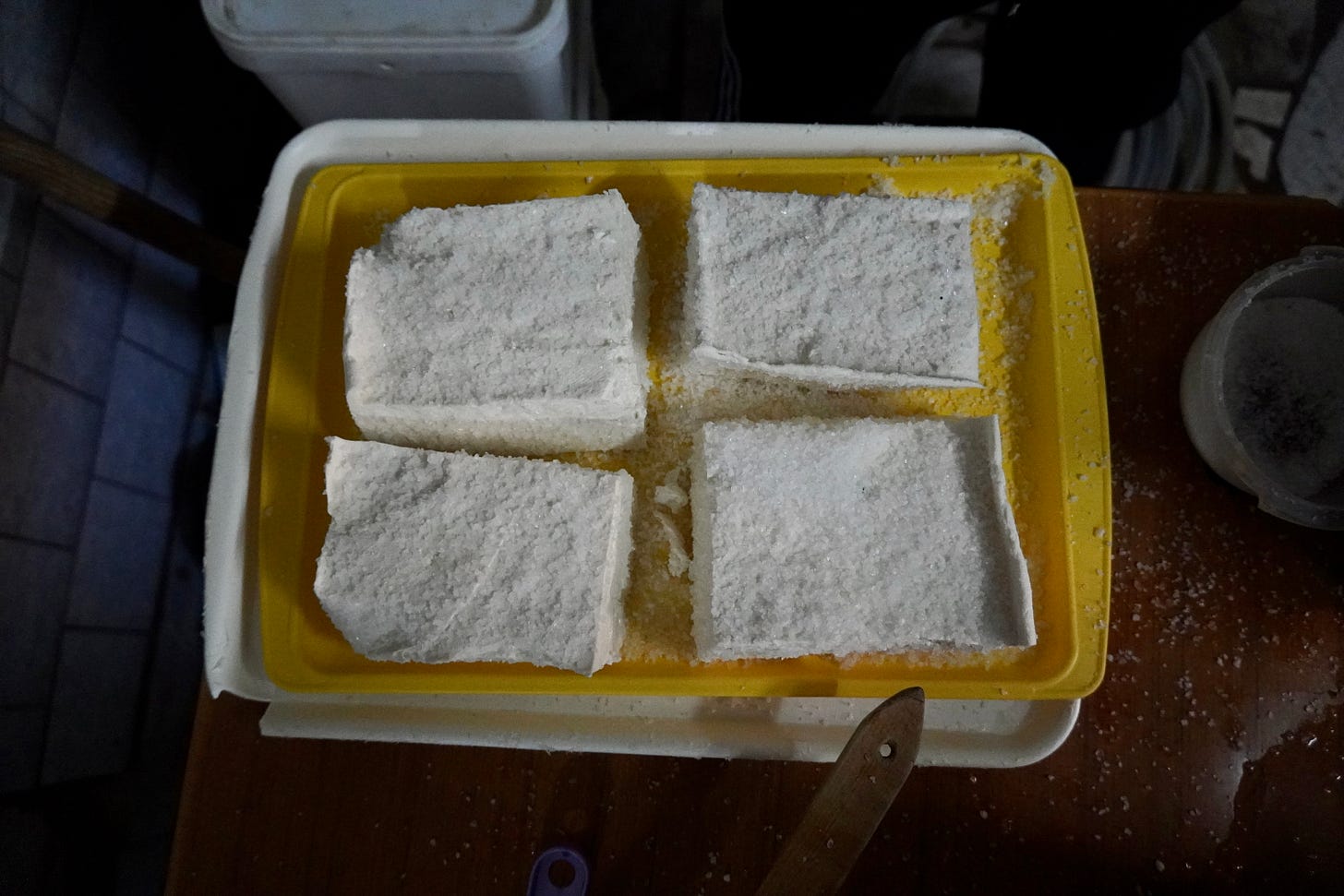

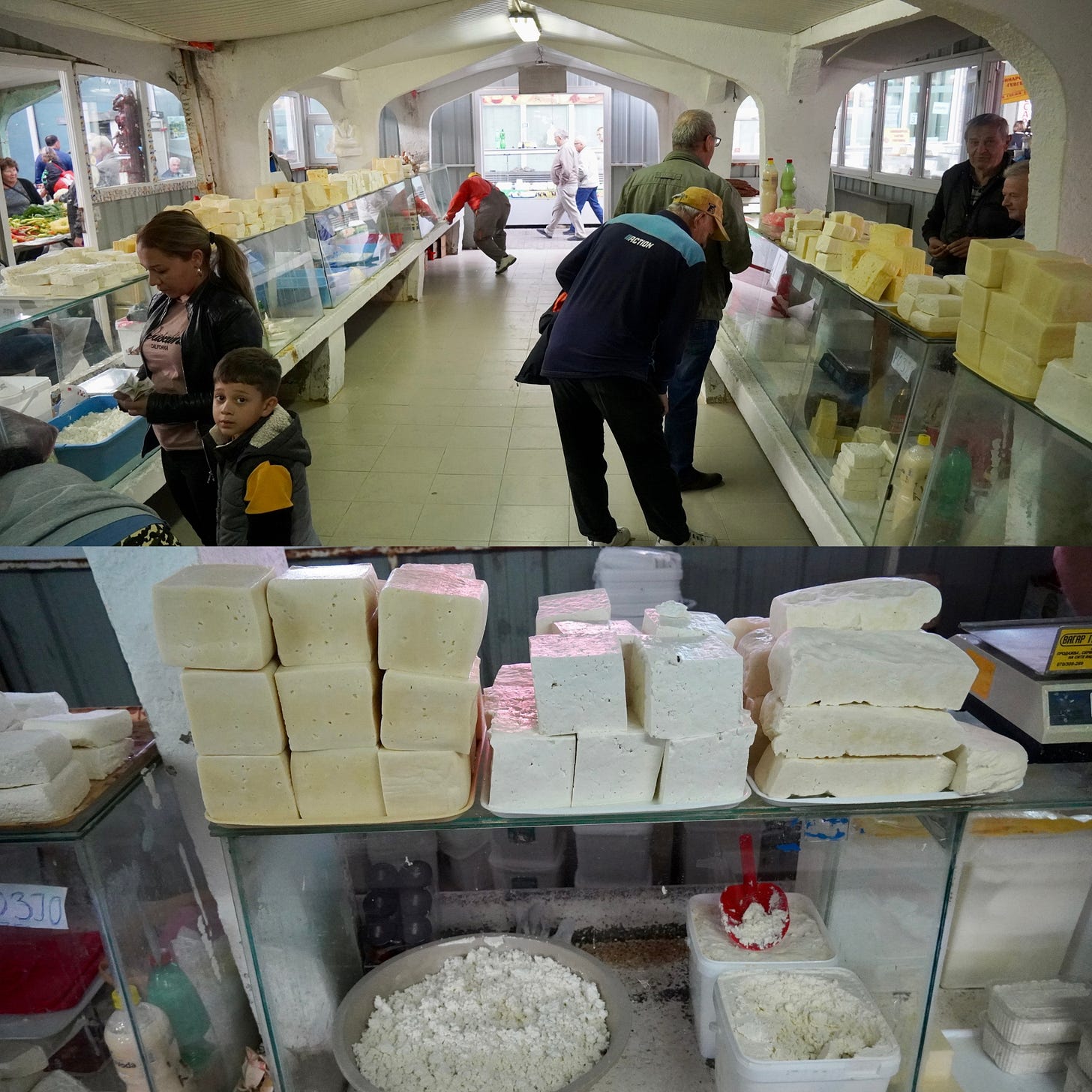
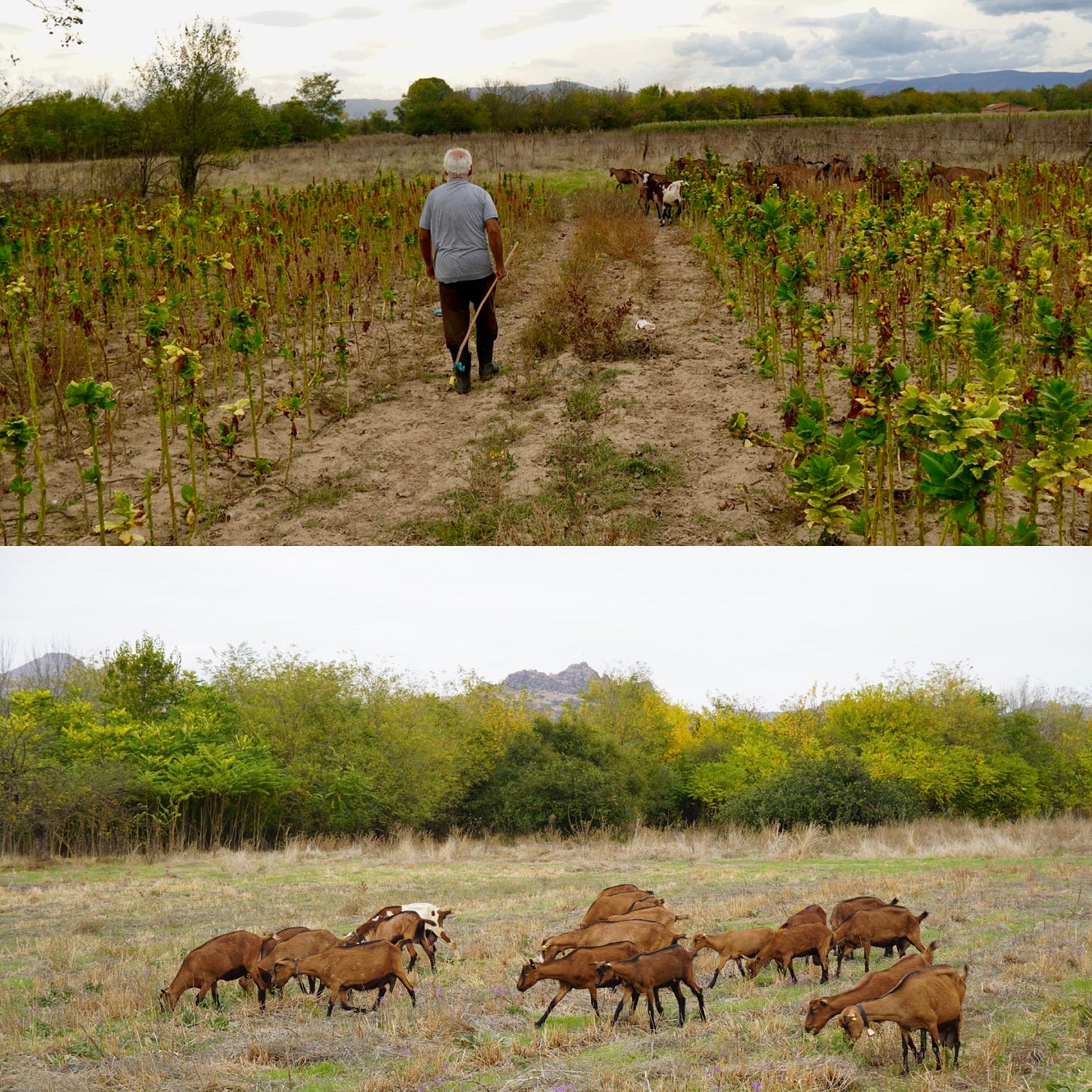


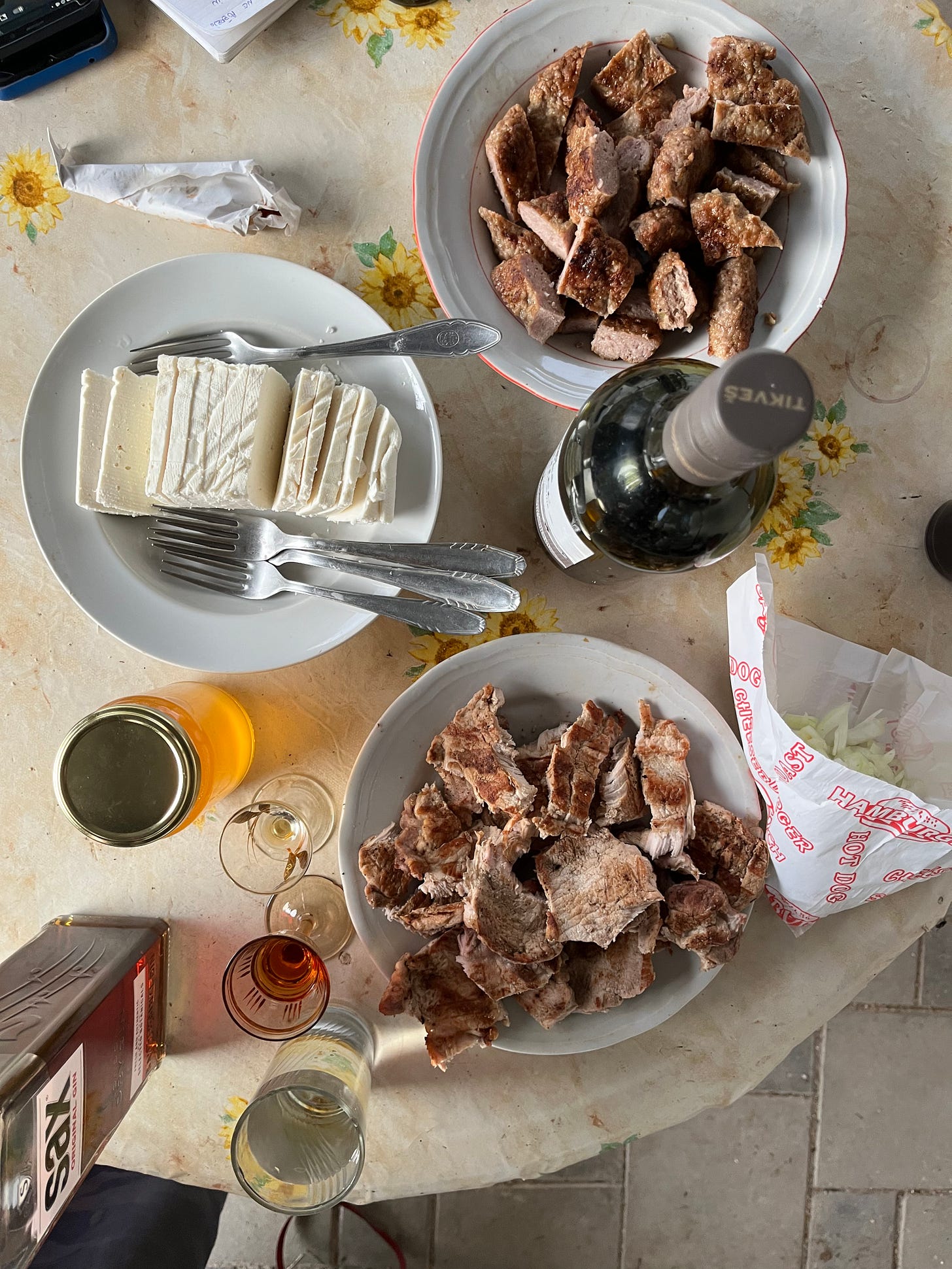

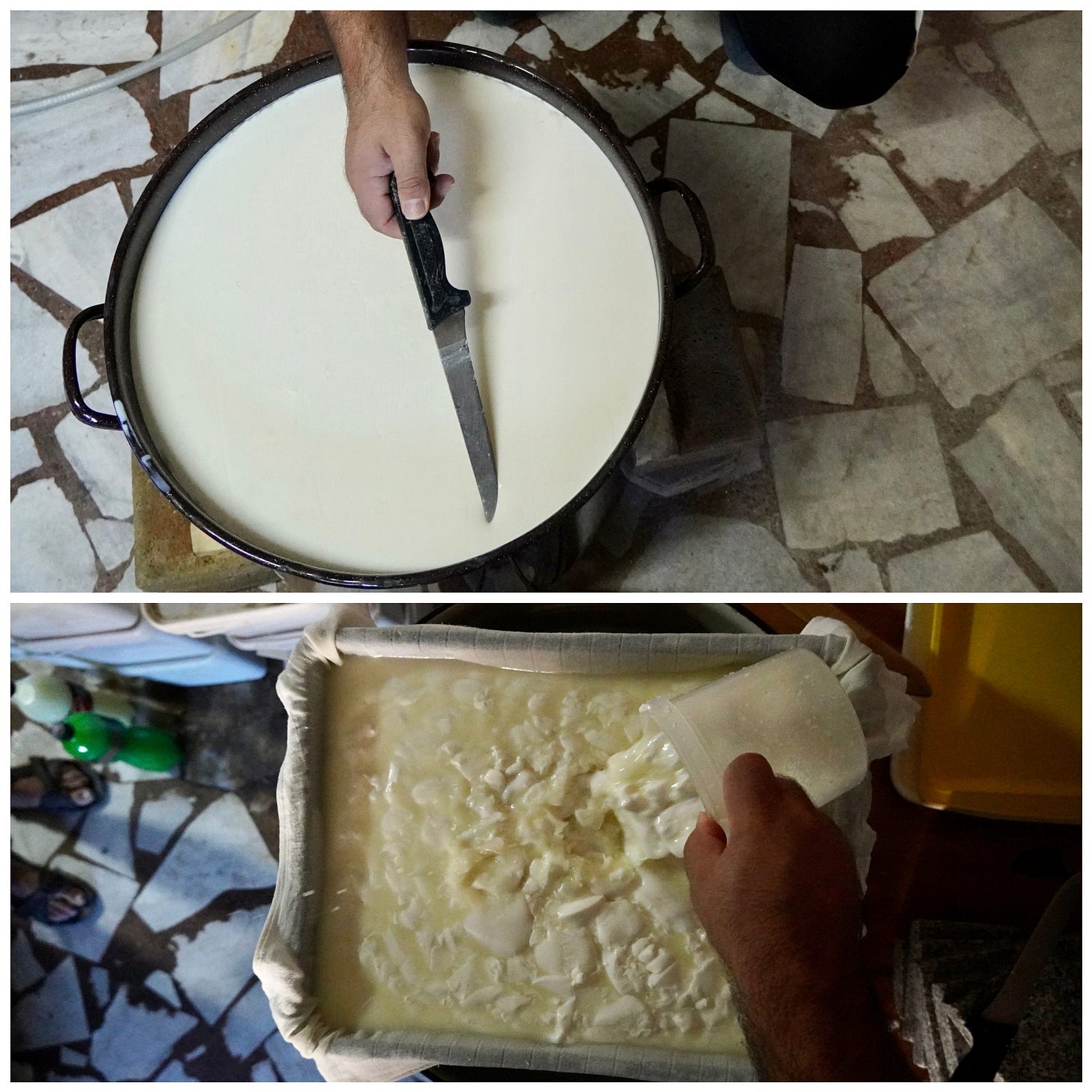

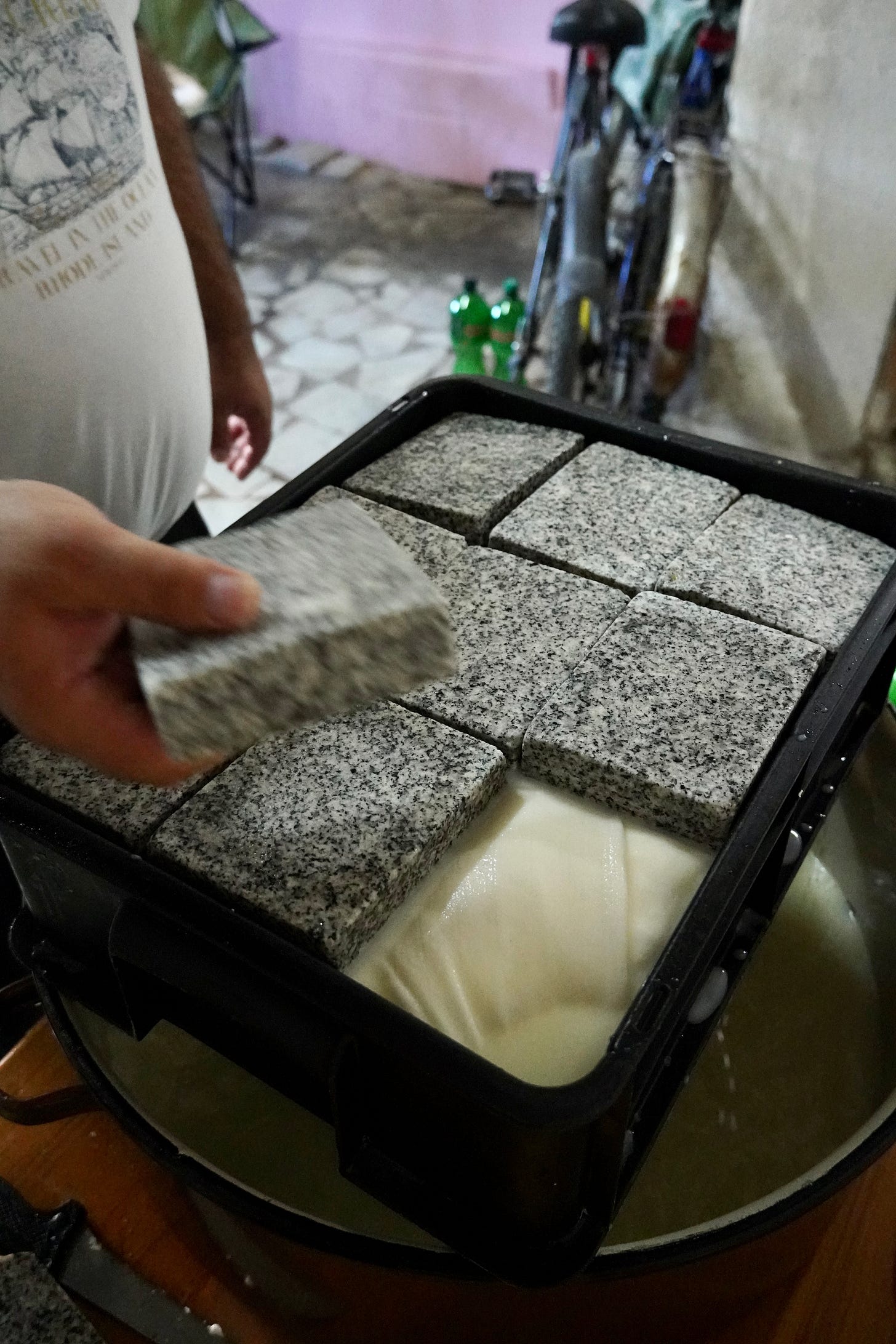
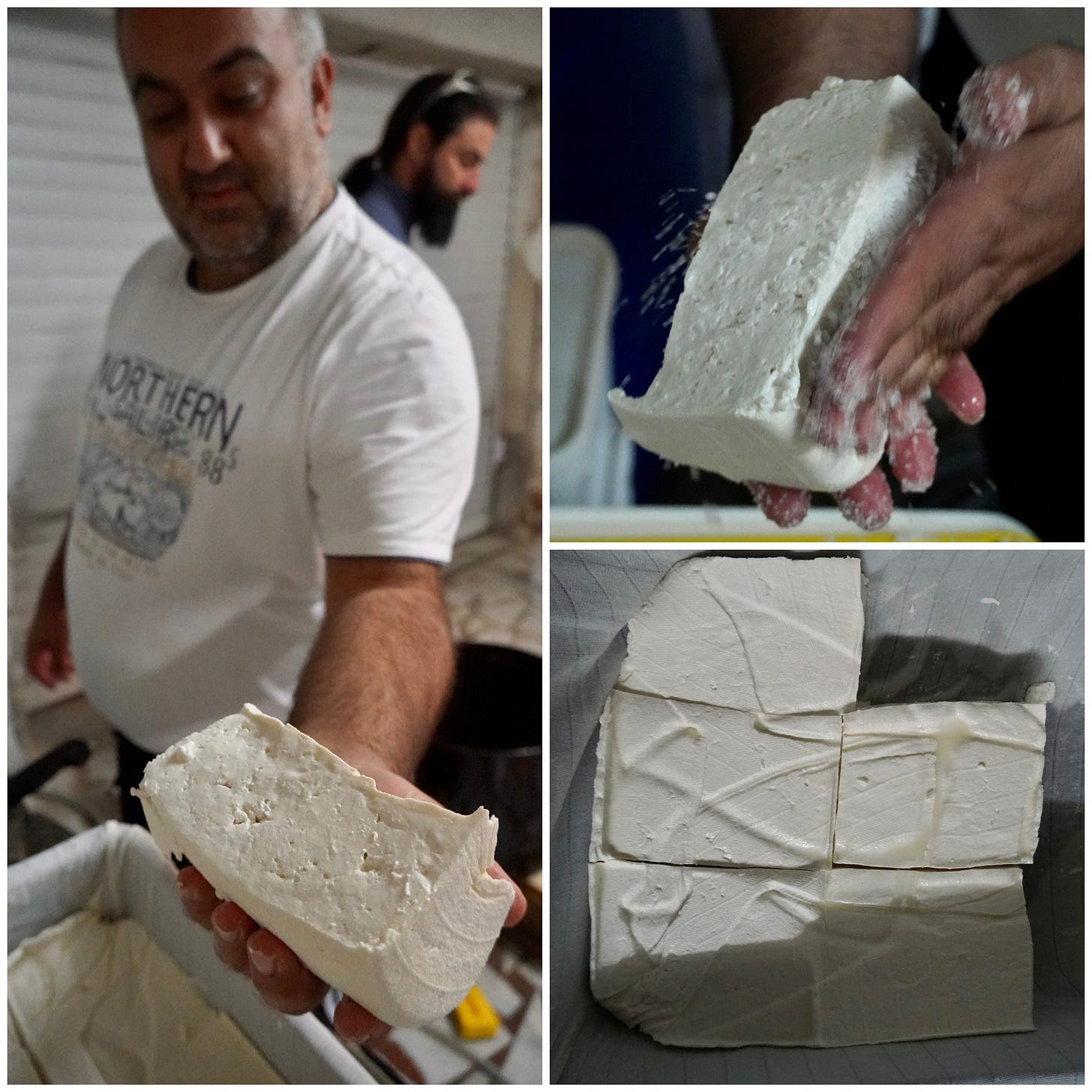
Loved your commentary here about the goat herding and all these details. Picking apart certain details and thinking about how they affect the flavour profile but you’ve shown how there are so many things that go into the cheese, from what the goats are eating and their diverse diet, all the way to the slab of marble he uses to weigh it down. Absolutely beautiful. The years of knowledge that has gone into this fairly simple practice, yet someone else trying to replicate the process in another part of the world would get different results. It’s mind blowing how magical fermentation is. Thank you for bringing us into this world. Happy travels!
1) I’d take a trip like you mentioned.
2) the water itself may be high in calcium, and perhaps the marble releases calcium as the brine becomes more acidic from whey being pulled into it. Those factors could help the cheese not getting slimy.
3) the natural starters are always in all raw milk anyway. As you pointed out, whatever quantity are already there, are helping provide the results he wants. Added starters provide predictability of acid production, flavor, and scheduling, and came into popularity when milk began being pasteurized in some areas around 1900. That is a longer and far more nuanced discussion than people realize.